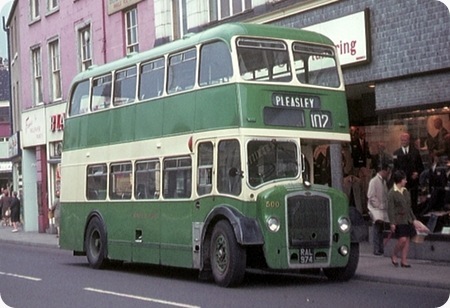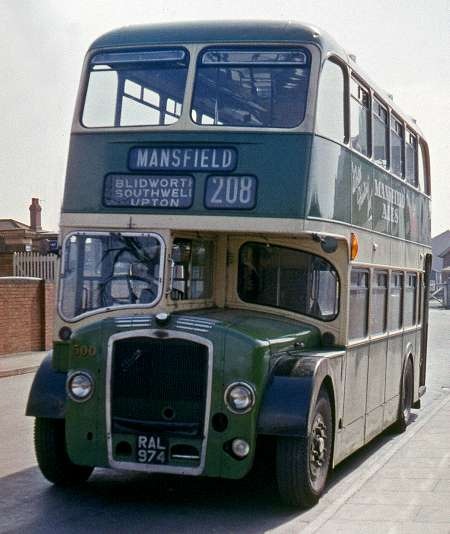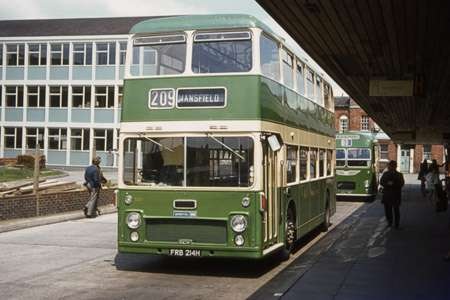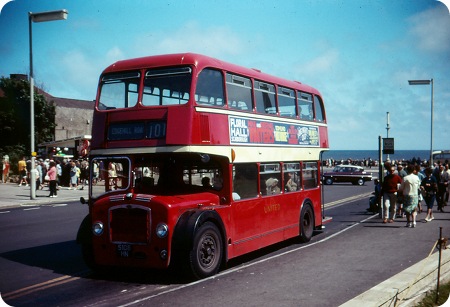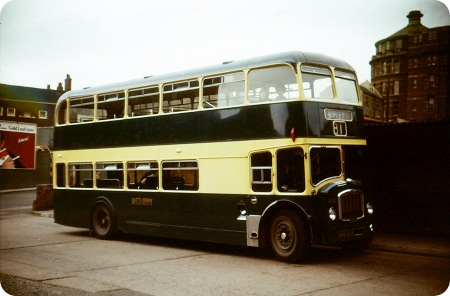Mansfield District – Bristol Lodekka LD6G – RAL 974 – 500
Mansfield District Traction Company Limited
1954
Bristol Lodekka LD6G
ECW H33/25R
I always liked the Bristol Lodekka with the original long grille-thought it gave the bus a more purposeful appearance. A chance visit to Mansfield in August 1968 found this example which appeared to be in excellent condition for its age.
Photograph and Copy contributed by Ian Wild
29/06/11 – 13:03
In 1969 several of these early Mansfield Lodekkas moved north to West Riding to enable the ill fated Wulfrunians to be withdrawn They entered service in Mansfield green and were quickly joined by others from Midland General and Lincs. Later some twenty plus almost new FLFs came from Bristol to complete the exercise
Chris Hough
29/06/11 – 14:44
Ah! delight in Mansfield, one of my favourite places. Firstly I agree with Ian about the long grille Lodekka, I’ve always thought the same. Secondly, this is particularly interesting because it was Mansfield District’s first Lodekka, new in 1954, platform doors fitted in 1957. I’ve always tended to think of Mansfield District as a sort of Mansfield Corporation, with its history of tramway operation and lots of high frequency short distance services, a very good example of which was the 102 as shown. In 1964, the Saturday service was; first bus 4.40am then every 10mins until 9am then every 5mins until 6.20pm then every 10mins until 11pm (last) and this wasn’t the only service between Mansfield and Pleasley, a timetable wasn’t really necessary! I find it a little odd that this bus isn’t sporting a full blind display, Mansfield District, Midland General and Notts and Derby were normally very fastidious about such things and their inspectors would ‘have a word’ with the conductor if the blinds weren’t displayed perfectly! The correct display in the via box for the 102 would have been MANSFIELD CENTRE, CHESTERFIELD ROAD, PLEASLEY (some journeys carried on to New Houghton)
As Chris H rightly says, some of these vehicles were transferred to West Riding as Wulfrunian replacements and were apparently considered to be amongst the better ones so transferred, not surprising considering MDT/MGO’s excellent maintenance standards. Also unusual is that this vehicle carries no adverts of any sort and I think looks much better for it!
Chris Barker
30/06/11 – 05:29
I too much preferred the long radiator and the traditional Bristol shape of it to the later version, which always gave me the annoying impression of having been in a lower end collision and being amateurishly repaired by "chopping off the damaged bit and putting in a new straight lower shape." I also have an aversion, on all buses, to front square number plates with two rows of three characters – the normal long number plate with all characters in one line looks far tidier at the front and, in many cases, even at the back also.
Chris Youhill
30/06/11 – 05:35
This vehicle’s sister, RAL 976, did some sightseeing work here in Halifax, Nova Scotia in the early seventies, alongside an ex London RT, and at the time made a fine sight in its green livery, I think it had been with West Riding before export to Canada. It moved on years ago, to destination unknown, and I suppose it presumably could still exist, but more than likely has succumbed to the scrapman’s hammer by now.
Dave Careless
30/06/11 – 16:07
I am not at all surprised to observe the superb condition which the Mansfield Lodekka demonstrates! Ignoring any design preferences of individual enthusiasts, I struggle to define any ECW bodied vehicle as being "worn". Most would seem to be capable of completing a 40 year life cycle.
Undoubtedly the finest exponents of bus building which ever existed, the quality and innovation of which was, in my humble opinion, totally unmatched. It is to be greatly regretted that this wonderful company was allowed to disintegrate!
ECW bodies never failed to exude total quality, their obsolescence being defined simply in terms of "fashion".
I have no "axe to grind", and enjoy, as an enthusiast, other products than those from Lowestoft, but wonder if former professionals from within the industry are able to destroy this "illusion" of mine?
John Whitaker
01/07/11 – 05:19
Although I cannot fault the general impression of these vehicles, I was never that keen on the ‘hump’ below the driver’s cab, giving to me, at least, the impression that it had had a front-end shunt and was yet to be repaired!
AS Chris B says, the absence of adverts greatly enhances its looks. Were that they’d all been like this!
Chris Hebbron
25/07/11 – 21:01
The Photo of RAL 974 is not standing on the 102 Rank and as a driver for MDT I am suggesting that the vehicle will be driven round to Queen Street to duplicate the service 102 bus to Pleasley hence the via blind is left empty.
John Hellewell
I have put this comment on exact as I got it, I did not get the next to last word but had a good laugh when the penny dropped well done Mr A Non
15/08/11 – 13:01
old5oo thank you 44 sinse i drove her the fleet numbers500to 532 all back rsenders niceone
A Non
16/09/14 – 07:44
I used to be a driver for Mansfield District from 1968 and my father did fifty years for Mansfield it takes me back. I still am in the bus industry I’m a supervisor for West Coast Motors on the west coast of Scotland it was a good time at MDT. I was at Midland Travel as well.
Colin Steele
16/09/14 – 09:54
"ECW bodies never failed to exude total quality…"
Not quite, John. The B51 coach body was an absolute aesthetic and structural abomination, utilising large areas of unsupported glass fibre that simply collapsed in service. All the fittings were flimsy and the luggage boots leaked rainwater and road dirt. It was produced under the directives of the Stokes ‘led’ Leyland empire and so bad was it that it must have hastened the ultimate demise of ECW.
Roger Cox
16/09/14 – 12:08
Yes, but I think that it’s a given that any Stokes era history is a period not to savour and that John was thinking of "real" ECW in the same way that I differentiate between Leyland and British Leyland. You are absolutely right that the B51 was an abomination but its failings revolve around British Leyland trying to slap a body literally designed around a rear engined vehicle (the Bristol RELH) onto mid-engined designs without any thought to structural integrity. [Even the earlier, purer, versions on Leopards for SELNEC/GMT suffered similar problems but they were too embarrassed to mention it at the time.] Sadly, at the same time as the B51, Willowbrook offered its own abomination, the 003. Duple were not much better either and, as we all know, Plaxton eventually joined the slide into mediocrity or worse.
David Oldfield
17/09/14 – 07:13
I seem to recall that United took some Leopards with the plasticky B51 bodies for National Express work. The chassis did not have sufficient fixings to cater for the enormous boots required, worked themselves loose and at least one fell off, strewing luggage all over the motorway.
Chris Hebbron
19/09/14 – 07:03
None at all Chris. It was an unsupported boot. Originally the body was (semi) integral with the RE frame – and thus very rigid and strong. Here began its troubles.
David Oldfield
20/09/14 – 05:57
I wonder who dominated here, David O, engineers or accountants!
Chris Hebbron
20/09/14 – 09:27
No brainer Chris. Got to be accountants. Whenever there’s a choice between experts/professionals and accountants the outcome is chaos – just have a closer look at the accountants. You don’t have to look too far to see who is at fault.
David Oldfield
05/10/15 – 07:07
I’ve finally dug out my photo of RAL 974 taken in Newark in 1961, at which time it was wearing advertisements.
Roger Cox
06/10/15 – 07:11
Thanks Roger, for that wonderful photo, Mansfield District had several services between Mansfield and Newark but the principal ones were the 208/209 which combined to provide an hourly headway (even on Sundays) between the two towns by slightly different routes. On Saturdays the frequency was doubled up to half hourly for most of the day.
Although Newark had a bus station, for some reason all the MDT services at that time terminated at Northgate railway station which can be seen in the background. They did move into the bus station in later years.
Chris Barker
07/10/15 – 06:59
Here is a slightly more modern Mansfield District vehicle – but still in the traditional livery – a Bristol VRT/ECW Series 1, seen in Newark Bus Station about to return to Nottingham via the 209 route in 1971.
John Stringer
07/10/15 – 15:52
Slip of the fingers there John? It says "Mansfield" on the blind! Nottingham was the 215. The fundamental difference between the 208 (via Blidworth, Southwell, Upton – as shown on the Lodekka) and the 209 was that the latter ran via Rolleston and Fiskerton between Newark and Southwell. I fancy it was meant to substitute for the train following closure of the Rolleston Junction – Southwell branch line.
Stephen Ford
Quick links to the - Comments Page - Contact Page - Home Page
